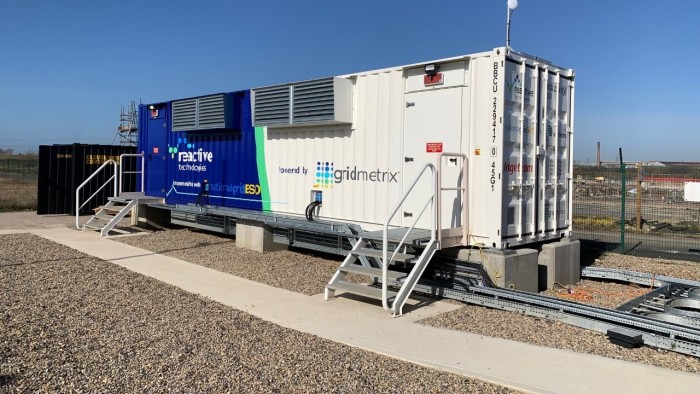Reactive Technologies eases transition to cleaner energy

Simply sign up to the Renewable energy myFT Digest -- delivered directly to your inbox.
Wind farms and solar panels dotted around Britain are the most visible signs of the country’s shift away from fossil fuels and towards cleaner electricity generation.
But a shipping container in Teesside, north-east England, is the site of equally vital — if less visible — work to ensure that this new energy system runs smoothly, and the lights stay on.
From the unit at Wilton International industrial park, Reactive Technologies sends pulses of power into the electricity grid as part of its unique method of measuring inertia.
Inertia, in electricity grids, refers to the energy stored in generators’ fast-rotating turbines, which, if a power plant fails, is enough to keep the grid operating until back-up power supplies automatically kick in. It is a key challenge for grid operators around the world as they try to move away from electricity generated by coal-fired and gas-fired power stations to cut carbon dioxide emissions.
The electricity system needs inertia to help keep electricity supply and demand constantly balanced, thus avoiding power cuts. However, inertia is not naturally provided by wind turbines and solar farms.
“This is a physics-based problem and, while all grids are slightly different, they are all facing the same challenge,” explains Marc Borrett, co-founder and chief executive of Reactive Technologies, which has a head office in London and an R&D centre in Finland.
“We have a new toolkit to give them a better insight into how they can safely transition to net zero [carbon emissions].”
Borrett set up Reactive in 2010, along with ex-Nokia technology developer Heikki Huomo, after his first start-up — the Aim-quoted Innovision Research and Technology — was sold to Broadcom for $47.5mn that year.
Reactive initially started exploring how to get household appliances, such as freezers or immersion heaters, to adjust how much electricity they use, depending on how much clean electricity is available.
In a world first in 2016, it managed to send a communications signal through the electricity grid, with the Morse code for “UK-OK” received by devices across the country.
However, Reactive’s engineers found that the pace at which the signal was received depended on the stability of the system. From this, they realised they could “turn the technology on its head and use it in a different way to actually measure the stability of the grid”, explains Borrett.
So Reactive started working on developing the technology with National Grid ESO, the UK’s electricity system operator. Then, in 2019, the operator signed a six-year deal to deploy Reactive’s flagship GridMetrix system. It wants to be able to run the grid without any gas-fired power plants online for periods of time by 2025.
In very simple terms, the technology works by sending out pulses of power and monitoring how they behave and the impact they have. Reactive says its system is the only one able precisely to measure, rather than estimate, inertia — which helps grid operators make better informed decisions about how to balance supply and demand second-by-second. This often involves paying wind farms to switch off, or buying inertia services.
“Where they’ve been only able to estimate the stability, [grids] have tended to be very conservative,” says Borrett. In other words, they underestimate how much renewable power they can handle — but with more precise data, Borrett says, “we avoid the need for renewables to be curtailed 80 per cent of the time.”
Reactive is still at an early stage, reporting turnover of £2.9mn and a loss of £5.6mn in the year to the end of March 2022, its latest available accounts filed at Companies House.
But it is poised for growth. Taiwan Power Company signed a deal in September to deploy GridMetrix, while Reactive is also running a demonstration project in Australia and targeting deals with other grid operators around the world.
Separately, it also supplies electricity system data and forecasts to energy traders and renewable energy developers. Borrett expects the workforce to grow from about 60 now to more than 150 over the next four or five years.
Michael Liebreich, a former adviser to the UN on sustainable energy, says Reactive has a large business opportunity, given the scale of the challenge ahead as countries try to decarbonise.
Energy research provider BloombergNEF estimated in March that around $17.3tn needs to be invested in expanding electricity grids by 2050. Reactive could capture some of that investment by helping grid operators run the system more efficiently, instead.
“It’s a great export opportunity,” says Liebreich. “Grids across the world have this challenge as they move towards less natural inertia.”
Backers helping the company scale up include the Bill Gates-backed investment fund Breakthrough Energy Ventures, which supports companies that it believes have the potential to cut at least 500mn tonnes of greenhouse gas emissions every year.
Breakthrough invested in August 2021 as part of a $15mn fundraising led by investment company BGF. Toshiba Energy Systems & Solutions came on board as a strategic investor in May 2022, as did Accenture in December 2020.
Mark Hartney, principal at BEV and a director at Reactive following the investment, says Reactive has a “very clever, really insightful” way to measure inertia.
“We clearly believe this is lined up well with long-term trends for decarbonisation and the challenges that brings,” he adds.
As Reactive looks to roll its technology out worldwide, Borrett is relaxed about the prospects of others catching up.
“We have arrived at this from a slightly left-field angle,” he says. “No one else had been thinking about this as an approach, so the patent portfolio we have built is significant.
“We feel we have a very protected, defensible position that should mean we have a sustainable business for the future.”

Comments